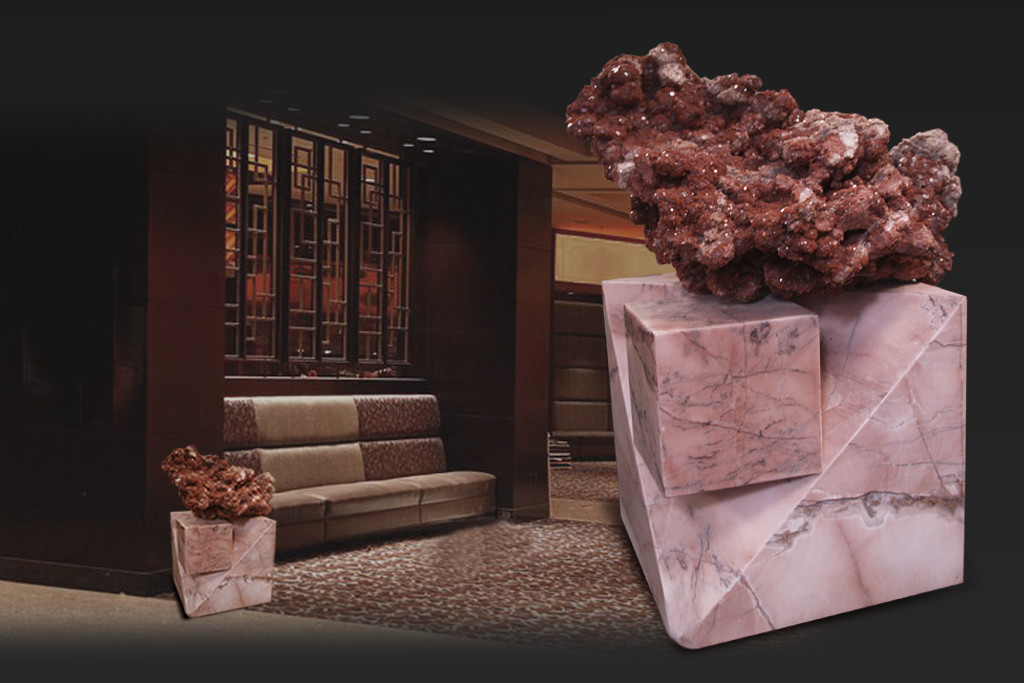
Aragonite on Marble Base
Origination: Mexico
Approximate: Height (on marble base)- 31" - Width - 26" - Depth - 26"
Aragonite Stone: $5,900.00 U.S.D.
Marble Base: $3,000
Contact us by email or phone (609-718-0542) if you are interested in more information about this piece.
Send us an email:
Aragonite is a carbonate mineral, one of the two common, naturally occurring, crystal forms of calcium carbonate, CaCO3 (the other form being the mineral calcite). It is formed by biological and physical processes, including precipitation from marine and freshwater environments. Aragonite's crystal lattice differs from that of calcite, resulting in a different crystal shape, an orthorhombic system with acicular crystals. Repeated twinning results in pseudo-hexagonal forms. Aragonite may be columnar or fibrous, occasionally in branching stalactitic forms called flos-ferri ("flowers of iron") from their association with the ores at the Carinthian iron mines. In aquaria, aragonite is considered essential for the replication of reef conditions. Argonite both provides the materials necessary for much sea life and also keeps the pH of the water close to its natural level, to prevent the dissolution of biogenic calcium carbonate.[6]
Aragonite has been successfully tested for the removal of pollutants like zinc, cobalt and lead from contaminated wastewaters. The type location for aragonite is Molina de Aragón (Guadalajara, Spain), 25 km from Aragon for which it was named in 1797. An aragonite cave, the Ochtinská Aragonite Cave, is situated in Slovakia. In the USA, aragonite in the form of stalactites and "cave flowers" (anthodite) is known from Carlsbad Caverns and other caves. Massive deposits of oolitic aragonite sand are found on the seabed in the Bahamas.Aragonite forms naturally in almost all mollusk shells, and as the calcareous endoskeleton of warm- and cold-water corals (Scleractinia). Several serpulids have aragonitic tubes. Because the mineral deposition in mollusk shells is strongly biologically controlled, some crystal forms are distinctively different from those of inorganic aragonite. In some mollusks, the entire shell is aragonite; in others, aragonite forms only discrete parts of a bimineralic shell (aragonite plus calcite).
Aragonite also forms in the ocean and in caves as inorganic precipitates called marine cements and speleothems, respectively. The nacreous layer of the aragonite fossil shells of some extinct ammonites forms an iridescent material called ammolite.Aragonite is metastable and is thus commonly replaced by calcite in fossils. Aragonite older than the Carboniferous is essentially unknown. It can also be synthesized by adding a calcium chloride solution to a sodium carbonate solution at temperatures above 70 °C or in water-ethanol mixtures at ambient temperatures. Aragonite Clusters (Morocco) - These natural pieces of Aragonite are beautiful specimens with the crystals clustered onto each other. They are a nice peachy brown in color. Aragonite is a calcium carbonate, orthrombic crystal, with these particular pieces being commonly known as the "sputnik" form of Aragonite.
SHIPPING AND DELIVERY: We use only the most reliable and trustworthy crating and shipping services available for delivery of your TerraPiedra purchase. The price for each stone does not include packing, crating, insurance or transportation. Shipping and delivery costs will be based on location and method of transportation. If you have a shipping service that you prefer to use, by all means we will be very happy to coordinate with them so your Terra Piedra stone arrives in perfect condition.